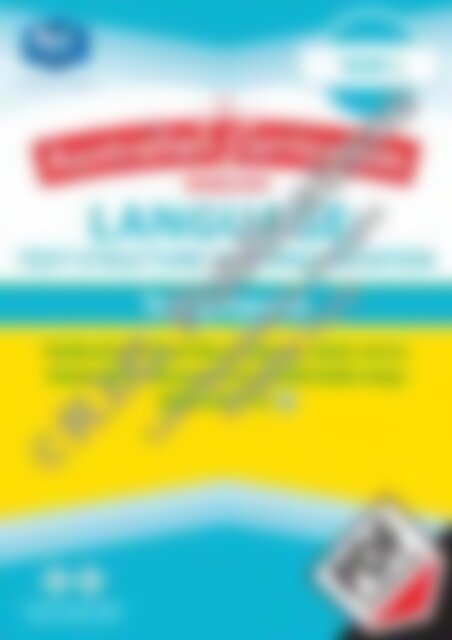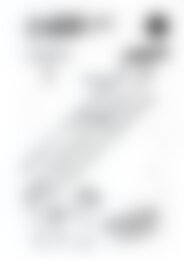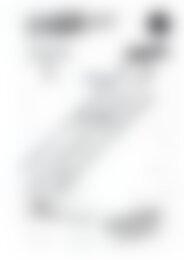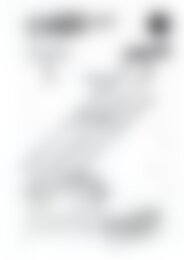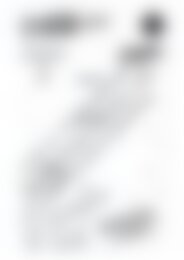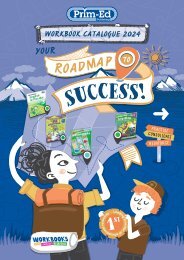20875 ACE Language (Yr 1) Text Purposes
You also want an ePaper? Increase the reach of your titles
YUMPU automatically turns print PDFs into web optimized ePapers that Google loves.
Your partner in education<br />
YEAR 1<br />
ENGLISH<br />
LANGUAGE:<br />
TEXT STRUCTURE AND ORGANISATION<br />
<strong>Text</strong> purposes<br />
Understand that the purposes texts serve<br />
shape their structure in predictable ways<br />
(<strong>ACE</strong>LA1477)<br />
Australian Primary Publisher<br />
of the Year 2015 and 2016
Australian Curriculum English – <strong>Language</strong>: <strong>Text</strong> structure and organisation (Year 1)<br />
Foreword<br />
Australian Curriculum English – <strong>Language</strong>: <strong>Text</strong> structure and organisation (Year 1) is one in a series of seven teacher<br />
resource books that support teaching and learning activities in Australian Curriculum English. The books focus on<br />
the sub-strand of <strong>Text</strong> structure and organisation within the <strong>Language</strong> strand of the national English curriculum.<br />
The resource books include theoretical background information, activities to develop the content descriptions, blackline<br />
masters, resource sheets and assessment checklists, along with interrelated links to other English strands and sub-strands.<br />
Titles in this series are:<br />
• Australian Curriculum English – <strong>Language</strong>: <strong>Text</strong> structure and organisation (Foundation)<br />
• Australian Curriculum English – <strong>Language</strong>: <strong>Text</strong> structure and organisation (Year 1)<br />
• Australian Curriculum English – <strong>Language</strong>: <strong>Text</strong> structure and organisation (Year 2)<br />
• Australian Curriculum English – <strong>Language</strong>: <strong>Text</strong> structure and organisation (Year 3)<br />
• Australian Curriculum English – <strong>Language</strong>: <strong>Text</strong> structure and organisation (Year 4)<br />
• Australian Curriculum English – <strong>Language</strong>: <strong>Text</strong> structure and organisation (Year 5)<br />
• Australian Curriculum English – <strong>Language</strong>: <strong>Text</strong> structure and organisation (Year 6)<br />
Contents<br />
Format of this book .................................. iv – v<br />
<strong>Language</strong>: <strong>Text</strong> structure and<br />
organisation .............................................. 2–85<br />
Understand that the purposes texts serve shape their<br />
structure in predictable ways (<strong>ACE</strong>LA1477)<br />
© Australian Curriculum: Assessment and Reporting Authority 2012<br />
–Teacher information ................................................. 2<br />
–Activities to develop the content description ...... 3–10<br />
–Blackline masters ............................................. 11–25<br />
–Assessment checklist ............................................. 26<br />
–Interrelated English links ........................................ 27<br />
– Modes, capabilities and priorities covered by the<br />
activities in this content description ....................... 27<br />
Understand patterns of repetition and contrast in<br />
simple texts (<strong>ACE</strong>LA1448)<br />
© Australian Curriculum: Assessment and Reporting Authority 2012<br />
–Teacher information ............................................... 28<br />
–Activities to develop the content description .......... 29<br />
–Blackline masters and resource sheets .............. 30–51<br />
–Assessment checklist ............................................. 52<br />
–Interrelated English links ........................................ 53<br />
– Modes, capabilities and priorities covered by the<br />
activities in this content description ....................... 53<br />
Recognise that different types of punctuation, including full<br />
stops, question marks and exclamation marks, signal<br />
sentences that make statements, ask questions, express<br />
emotion or give commands (<strong>ACE</strong>LA1449)<br />
© Australian Curriculum: Assessment and Reporting Authority 2012<br />
–Teacher information ............................................... 54<br />
–Activities to develop the content description ......... 55<br />
–Blackline masters and resource sheets ............. 56–69<br />
–Assessment checklist ............................................. 70<br />
–Interrelated English links ........................................ 71<br />
– Modes, capabilities and priorities covered by the<br />
activities in this content description ....................... 71<br />
Understand concepts about print and screen, including how<br />
different types of texts are organised using page<br />
numbering, tables of content, headings and titles,<br />
navigation buttons, bars and links (<strong>ACE</strong>LA1450)<br />
© Australian Curriculum: Assessment and Reporting Authority 2012<br />
–Teacher information ............................................... 72<br />
–Activities to develop the content description .......... 73<br />
–Blackline masters and resource sheets ............. 74–83<br />
–Assessment checklist ............................................. 84<br />
–Interrelated English links ........................................ 85<br />
– Modes, capabilities and priorities covered by the<br />
activities in this content description ....................... 85<br />
Answers ................................................... 86–90<br />
R.I.C. Publications ® www.ricpublications.com.au Australian Curriculum English – <strong>Language</strong>: <strong>Text</strong> structure and organisation (Year 1)<br />
iii
Format of the book<br />
This teacher resource book includes supporting materials for teaching and learning in the sub-strand of <strong>Text</strong> structure and<br />
organisation within the strand of <strong>Language</strong> in Australian Curriculum English. All content descriptions in the sub-strand<br />
have been included, as well as teaching points based on the Curriculum’s elaborations.<br />
While the book focuses on the sub-strand of <strong>Text</strong> structure and organisation, activities and interrelated links to other<br />
strands and sub-strands have been incorporated.<br />
Each section supports a specific content description and follows a consistent format, containing the following information<br />
over several pages:<br />
• activities to develop the content descriptions • student blackline masters • resource sheets<br />
• interrelated English links<br />
• assessment checklist<br />
Answers relating to student blackline masters have been included at the back of the book.<br />
The length of each content description section varies.<br />
Teacher information includes background information relating to the content description, as well as<br />
related terms and desirable student vocabulary and other useful details which may assist the teacher.<br />
Related terms includes vocabulary<br />
associated with the content description.<br />
Many of these relate to the glossary<br />
in the back of the official Australian<br />
Curriculum English document;<br />
additional related terms may also have<br />
been added.<br />
Student vocabulary includes words<br />
which the teacher would use—<br />
and expect the students to learn,<br />
understand and use—during English<br />
lessons.<br />
Further resources by R.I.C.<br />
Publications or other publishers<br />
or authors are included where<br />
appropriate.<br />
?<br />
T<br />
E<br />
What this means<br />
provides a general<br />
explanation of the<br />
content description.<br />
Teaching points<br />
provides a list of<br />
the main teaching<br />
points relating to the<br />
content description.<br />
Elaborations are a<br />
list of elaborations<br />
based on those in the<br />
content description.<br />
Activities to develop the content<br />
description includes descriptions or<br />
instructions for activities or games<br />
relating to the content descriptions<br />
or elaborations. Some activities are<br />
supported by blackline masters or<br />
resource sheets. Where applicable,<br />
these will be stated for easy reference.<br />
Australian Curriculum English – <strong>Language</strong>: <strong>Text</strong> structure and organisation (Year 1) www.ricpublications.com.au R.I.C. Publications ®<br />
iv
Format of the book<br />
Blackline masters and resource<br />
sheets are provided to support<br />
teaching and learning activities<br />
for each content description.<br />
These include worksheets for<br />
class use, games, charts or other<br />
materials which the teacher might<br />
find useful to use or display in<br />
the classroom. For each blackline<br />
master or resource sheet, the<br />
content description to which it<br />
relates is given.<br />
Each section has a checklist<br />
which teachers may find useful as<br />
a place to keep a record of their<br />
observations of the activities to<br />
develop the content descriptions.<br />
Interrelated English links<br />
lists other links covered within<br />
the <strong>Language</strong> strand, Literature<br />
strand and Literacy strand of<br />
English that are incorporated in<br />
the activities provided with the<br />
content description. While the<br />
book’s approach focuses on the<br />
<strong>Text</strong> structure and organisation<br />
sub-strand, the links show the<br />
integration across the three<br />
strands.<br />
A table showing the <strong>Language</strong><br />
modes, General capabilities<br />
and Cross-curriculum priorities<br />
covered by the activities in each<br />
content description is provided.<br />
Answers for student worksheets<br />
are provided at the back of the<br />
book.<br />
R.I.C. Publications ® www.ricpublications.com.au Australian Curriculum English – <strong>Language</strong>: <strong>Text</strong> structure and organisation (Year 1)<br />
v
<strong>Text</strong> structure<br />
and organisation<br />
Understand that the purposes texts serve shape their structure in predictable ways (<strong>ACE</strong>LA1477)<br />
© Australian Curriculum: Assessment and Reporting Authority 2012<br />
Related terms<br />
<strong>Text</strong>s<br />
Written, spoken or multimodal forms of<br />
communication for a range of purposes.<br />
<strong>Text</strong> structure<br />
The manner in which information is organised<br />
within different text types; e.g. title,<br />
introductory paragraph, sequencing of events or<br />
steps, concluding paragraph.<br />
Imaginative texts<br />
<strong>Text</strong>s whose main purpose is to entertain.<br />
They may be in the form of traditional stories,<br />
poetry, plays, novels, picture books or fi lms, for<br />
example.<br />
Informative texts<br />
<strong>Text</strong>s whose main purpose is to provide<br />
information. They may be in the form of a<br />
procedure, report or explanation, for example.<br />
Persuasive texts<br />
<strong>Text</strong>s whose main purpose is to present a point<br />
of view and persuade a reader/listener/viewer.<br />
They may be in the form of an advertisement,<br />
argument or debate, for example.<br />
?<br />
T<br />
E<br />
What this means<br />
Teacher information<br />
• Students should understand that a text is written for a specifi c purpose; e.g. to give<br />
information, to entertain, to give instructions.<br />
• Students should understand that a text type is structured in a specifi c way to<br />
help serve the purpose for which it is written. For example, a recount tells about<br />
something that happened. It has an introduction to set the scene, followed by a<br />
description of the events that occurred in chronological order. A procedure such as a<br />
recipe has a list of ingredients, followed by a series of numbered steps that explain<br />
how to make the recipe.<br />
Teaching points<br />
• Students should become familiar with the text structures of different imaginative,<br />
informative and persuasive text types including narratives, recounts, reports,<br />
procedures, explanations and expositions.<br />
• Give students the opportunity to discuss and compare different types of familiar<br />
texts and identify the purpose of each text. Students need to consider why a text<br />
was written. What is its purpose? How do the reader and writer benefi t/learn from<br />
the text?<br />
• Understanding the structure of a particular text type will improve a student’s<br />
comprehension of a text of that type.<br />
• Opportunities to read, discuss and analyse a number of examples of a particular<br />
text type is a prerequisite for success in writing them.<br />
Elaborations<br />
E1. Compares and discusses the purposes for which a variety of familiar texts were<br />
written.<br />
E2. Identifi es and discusses the text structures of different text types.<br />
Student vocabulary<br />
text<br />
events<br />
narrative<br />
complication<br />
recount<br />
problem<br />
report<br />
resolution<br />
Further resources<br />
• Primary writing (Books A–B) R.I.C. Publications<br />
• Posters: Introducing text types/Understanding text types<br />
R.I.C. Publications<br />
• Interactive software: Introducing text types (Understanding text types)<br />
R.I.C. Publications<br />
• 60 Writing topics: Exploring text types. (Ages 5–7) Maureen Hyland<br />
• Another 60 writing topics: Exploring text types. (Ages 5–7) Maureen<br />
Hyland<br />
procedure<br />
explanation<br />
exposition<br />
argument<br />
conclusion<br />
ending<br />
classification<br />
description<br />
paragraph<br />
vocabulary<br />
title<br />
orientation<br />
Australian Curriculum English – <strong>Language</strong>: <strong>Text</strong> structure and organisation (Year 1) www.ricpublications.com.au R.I.C. Publications ®<br />
2
<strong>Text</strong> structure<br />
and organisation<br />
Understand that the purposes texts serve shape their structure in<br />
predictable ways (<strong>ACE</strong>LA1477)<br />
© Australian Curriculum: Assessment and Reporting Authority 2012<br />
Activities to<br />
develop the<br />
content description<br />
E1. Compares and discusses the purposes for which a variety of different texts were written.<br />
• Why did the author write this book? (page 11)<br />
Provide a variety of different books, fi ction and nonfi ction, for students to look at, read and/or have read to them. Include picture books, class readers<br />
or short novels with illustrations, traditional tales from around the world, myths and fables, comics, recipe books and reference books on topics students<br />
are learning about. Identify the author of a selected book, discuss what type of book it is and why the author wrote this book; i.e. its purpose. For<br />
example, a recipe book was written to teach/inform us how to cook something, a narrative such as There’s a hippopotamus on our roof eating<br />
cake by Hazel Edwards is an story written for children to enjoy the imaginative tale. The blackline on page 11 is provided for students to record their<br />
thoughts about a selected book.<br />
• Why was this text written?<br />
Involve the students in activities within the classroom, school, home and local community similar to the one above using multimodal texts and familiar<br />
texts that are not in book form. Students identify why the text was written; i.e. its purpose. <strong>Text</strong>s to use could include those:<br />
– written to inform, explain or teach something: signs or labels on doors and rooms around the school and community, texts on the board, wall charts<br />
in the classroom, posters around the school notifying students of an event, school newsletter (either email or pamphlet), brochures in doctor’s<br />
surgeries, instructions on games used in class, blurbs on book or DVD covers, party invitations, entrance sign information to a building such as a<br />
library or a zoo, webpages that relate to topics being covered in class<br />
– written to persuade: webpages with side advertising or pop-ups; TV advertisements (these are usually accompanied with sound, but identify what<br />
they see in the ad); large advertising posters (that are quite often digital) located on roadsides, at sporting events or on shop fronts<br />
– written to entertain or for enjoyment: imaginative texts students have written that are on display; myths, fables and other narratives found online.<br />
Interrelated English links: See page 27<br />
E2. Identifies and discusses the text structures of different text types.<br />
• Analysing text structures of various text types<br />
Pages 4 to 10 provide teacher information, student activities and examples of seven imaginative, informative and persuasive text types written in the<br />
forms of a narrative, a personal recount, two procedures (a recipe and instructions for making a craft work), a report, an explanation and an exposition.<br />
These pages support the blackline masters provided on pages 12 to 25.<br />
Each text type on pages 4 to 10 includes:<br />
– information for the teacher about the various structural features of the specifi c text type, and the purpose of the specifi c text type<br />
– a detailed analysis of the structural features of the text presented in the sample texts provided on pages 12 to 25<br />
– suggested activities for helping students analyse the structural features of the specifi c text type<br />
– answers for the student analysis worksheet are provided at the back of the book.<br />
• Making jigsaws of the text types<br />
To help students identify the structure of different text types, enlarge the sample texts on pages 12, 14, 16, 18, 20, 22 and 24. Cut them into sections;<br />
e.g. cut the procedure on page 16, ‘Fruity milkshake’, by title, goal, materials (What you need), steps and test. Write these headings on separate strips of<br />
card. Place the ‘jigsaw’ pieces of the procedure into a plastic sleeve or resealable bag labelled ‘Procedure’, along with the heading cards. Students can<br />
take out the pieces, lay the text in order and place each heading card next to the correct part of the procedure.<br />
• Looking at books<br />
Use the books collected for the activity in the fi rst bullet point at the top of the page. Talk about the structure of various texts and ask students to<br />
identify and describe these structures. For example, they will see numbered steps or bullet points in procedures such as those in a recipe book and<br />
separate paragraphs about different parts of a narrative with some illustrations in a storybook.<br />
Interrelated English links: See page 27<br />
R.I.C. Publications ® www.ricpublications.com.au Australian Curriculum English – <strong>Language</strong>: <strong>Text</strong> structure and organisation (Year 1)<br />
3
<strong>Text</strong> structure<br />
and organisation<br />
Understand that the purposes texts serve shape their structure in<br />
predictable ways (<strong>ACE</strong>LA1477)<br />
© Australian Curriculum: Assessment and Reporting Authority 2012<br />
Activities to<br />
develop the<br />
content description<br />
Imaginative text: Narrative<br />
Structural features of narratives<br />
A narrative is a text which tells a story—generally imaginative but can be based on facts. It may be written in the form of a myth, legend,<br />
short story, poem, folktale or playscript. Its purpose is to entertain and engage the reader in an imaginative experience.<br />
It includes:<br />
• Title<br />
• Orientation: the setting, time and characters<br />
• Complication: involving the main character(s) and a sequence of events<br />
• Resolution: to the complication<br />
• Ending: often showing what has changed and what the<br />
characters have learnt<br />
• Detailed analysis of sample narrative on pages 12 and 13<br />
Read the narrative on page 12 to the students and discuss the story with them. Give students the opportunity to identify words using contextual<br />
information or phonic analysis. Explain this story is based on an Australian Aboriginal Dreaming story. Help them identify the purpose of the text and the<br />
structural features that make it a narrative; i.e. the orientation, problem or complication, events in chronological order, the resolution or how the problem<br />
was solved and the ending. (Refer to the copy of the student text below.) Assist students to analyse the narrative using the questions on page 13.<br />
Title<br />
Orientation<br />
Who, when and where<br />
Complication<br />
The problem confronting echidnas<br />
Events<br />
In chronological order<br />
How the echidna got its spines<br />
Long ago in the Australian bush, echidnas did not have spines. They just had fur.<br />
Some echidnas liked to hide from their enemies among rocks. Others liked to hide in hollow<br />
logs. But their enemies could still catch them and eat them.<br />
One day, an echidna wanted some ants to eat. It crept out of its hiding place in some rocks. It<br />
looked under some logs. No ants were there. It looked under the bark of trees. No ants were<br />
there. Where could they be hiding?<br />
At last it found some hiding under a grass tree. It crawled under the tree to reach them. As<br />
it did so, some spines from the grass tree fell on its back. No matter how hard it shook, the<br />
spines would not come out.<br />
Resolution<br />
How the problem was solved<br />
Ending<br />
Showing what has changed<br />
After the echidna ate lots of ants, it began to go back to its home. A dingo saw it and ran<br />
towards it. The echidna got a fright and curled up into a ball. When the dingo reached the<br />
echidna, it could not eat it. The spines pricked the dingo’s mouth.<br />
Now all echidnas have spines. Whenever they get a fright, they curl up into a ball so only their<br />
spines can be seen.<br />
• Film analysis<br />
Students view an age-level appropriate multimodal imaginative text (in the form of a narrative) on a DVD or online story. Afterwards, they can identify<br />
the structural features; i.e. orientation, complication, events, resolution and ending. Use page 13 as a guide.<br />
• Comparing a narrative and a report<br />
This narrative is based on a Dreaming story about how an echidna got its spines. The report on page 20 is about echidnas. Some facts about echidnas<br />
are included in both texts; e.g. what an echidna uses its spines for, illustrations of echidnas. Students can identify these aspects and read how they are<br />
presented in a different manner/structure in a narrative as compared to a report.<br />
• Comparing different narratives<br />
Look at a variety of different types of narratives: traditional tales, poetry, humorous stories, mystery stories and discuss how they all have a setting, plot,<br />
events and a problem that was solved; i.e. a similar structure. In simple terms, compare the different settings, characters and plots and what makes the<br />
texts different, even though they are all narratives (stories).<br />
• Writing a narrative<br />
After students are familiar with the structural features of a narrative, the next step is to guide them to plan their own text, write a draft, edit their work<br />
and publish a fi nal copy. Frequent modelled writing is an effective way of guiding students in the planning and writing process. Model plans with the<br />
headings ‘Title’, ‘Orientation’, ‘Events’ (these will include a ‘complication’ or ‘problem’), ‘Resolution’ and ‘Ending’. Then students can create their own<br />
narratives. Suggested or set topics are helpful to students.<br />
Australian Curriculum English – <strong>Language</strong>: <strong>Text</strong> structure and organisation (Year 1) www.ricpublications.com.au R.I.C. Publications ®<br />
4
<strong>Text</strong> structure<br />
and organisation<br />
Understand that the purposes texts serve shape their structure in<br />
predictable ways (<strong>ACE</strong>LA1477)<br />
© Australian Curriculum: Assessment and Reporting Authority 2012<br />
Activities to<br />
develop the<br />
content description<br />
Imaginative text: Personal recount<br />
Structural features of recounts<br />
A recount is a text which retells events as they happened in time order. It may be factual, personal or imaginative. A recount may be written<br />
in the form of a diary, letter, journal, conversation, interview, biography, autobiography, history, newspaper report or eyewitness account. Its<br />
purpose is either to inform or entertain the audience (or both).<br />
It includes:<br />
• Title<br />
• Orientation: all relevant background (who,<br />
when, where, why)<br />
• Events: signifi cant events in detail<br />
• Ending: often with an evaluative comment<br />
• Detailed analysis of sample recount on pages 14 and 15<br />
Read the recount on page 14 with the students and discuss the story with them. Give students the opportunity to identify words using contextual<br />
information or phonic analysis. Help them identify the purpose of the text and the structural features that make it a recount; e.g. the orientation, order of<br />
events and the conclusion. (Refer to the copy of the student text below.) Assist students to analyse the recount using the questions on page 15.<br />
Title<br />
Orientation<br />
Who, when, where and why<br />
Events<br />
Signifi cant events in detail<br />
Bella’s trip to the vet<br />
On Saturday, Dad and I took our cat, Bella, to visit the vet. She had a sore ear.<br />
First I put a blanket on the bottom of Bella’s cat box. Then we put her in the box. Some cats<br />
don’t like being in a cat box, but Bella loves it.<br />
When we got to the vet, Dad got Bella out of the car and carried her inside in her box. We sat on<br />
the seats to wait our turn.<br />
Next to us was a girl and her mum with a puppy on a lead. The puppy put its nose up close to<br />
Bella’s box. Bella made a loud ‘Miaow!’. The puppy jumped in fright and crept up close to the<br />
girl.<br />
About ten minutes later it was our turn. We told the vet that Bella had been rubbing her right<br />
ear and that it was red on the outside. The vet looked deep inside Bella’s ear. Bella wriggled a<br />
little bit. The vet told us she had an ear infection. Then the vet got some drops that would fi x<br />
Bella’s ear.<br />
Conclusion<br />
Often with an<br />
evaluative comment<br />
As we were leaving, the vet said Bella was one of her favourite cats. Bella looked at the vet from<br />
her box and purred loudly.<br />
• Film analysis<br />
Students view an age-level appropriate multimodal imaginative text (in the form of a recount) on a DVD or online story. Afterwards, they can identify the<br />
structural features; i.e. orientation, events in chronological order and conclusion. Use page 15 as a guide.<br />
• Writing a recount<br />
After students are familiar with the structural features of a recount, the next step is to guide them to plan their own text, write a draft, edit their work<br />
and publish a fi nal copy. Frequent modelled writing is an effective way of guiding students in the planning and writing process. Model plans with the<br />
headings ‘Title’, ‘Orientation’, ‘Events’ (these will be in chronological order) and ‘Conclusion’. Then students can create their own recounts. Suggested or<br />
set topics are helpful to students.<br />
R.I.C. Publications ® www.ricpublications.com.au Australian Curriculum English – <strong>Language</strong>: <strong>Text</strong> structure and organisation (Year 1)<br />
5
<strong>Text</strong> structure<br />
and organisation<br />
Understand that the purposes texts serve shape their structure in<br />
predictable ways (<strong>ACE</strong>LA1477)<br />
© Australian Curriculum: Assessment and Reporting Authority 2012<br />
Activities to<br />
develop the<br />
content description<br />
Informative text: Procedure<br />
Structural features of procedures<br />
A procedure is a text which outlines how something is made or done. Its purpose is to inform the reader. A procedure may be written in the form<br />
of a recipe, instructions for making something, an experiment, an instruction manual, a maths procedure, how to play a game, how to operate an<br />
appliance, how to use an atlas or how to deal with a problem.<br />
It includes:<br />
• Title<br />
• Goal: the purpose of the procedure shown clearly and precisely<br />
• Materials: a list of materials or requirements under appropriate<br />
headings or layout<br />
• Steps: the method in a detailed, logical sequence<br />
• Test: an evaluation (if appropriate)<br />
• Detailed analysis of sample procedure on pages 16 and 17<br />
Read and discuss the procedure on page 16 with the students, using the illustrations to help them understand the instructions in the steps. Assist them<br />
to identify the purpose of the text and the structural features that make it a procedure in the form of a recipe; e.g. the goal/purpose, materials (in this<br />
case, equipment and ingredients), steps and test. (Refer to the copy of the student text below.) Assist students to analyse the procedure using the<br />
questions on page 17. Note: To answer the ‘Test’ properly, students could make milkshakes in class and taste them. In the ‘Steps’ section, point out that<br />
not all procedures have six steps; some have more and others fewer.<br />
Title<br />
Goal<br />
The purpose of this procedure is to<br />
make a fruity milkshake for a yummy<br />
drink.<br />
Materials<br />
A list of materials needed under an<br />
appropriate heading<br />
Fruity milkshake<br />
Make a fruity milkshake for a yummy drink!<br />
You will need:<br />
• 4 strawberries • 1 banana • blender<br />
• 1 cup of milk<br />
• 2 scoops of vanilla ice-cream<br />
• 1 teaspoon • 2 glasses • 2 straws<br />
Steps<br />
The steps are written clearly and<br />
concisely in a logical sequence. They<br />
are usually numbered.<br />
Steps:<br />
1. Wash the strawberries and pull<br />
out the green tops.<br />
2. Peel the banana.<br />
3. Put everything into the blender. 4. Blend until smooth and frothy.<br />
5. Pour the milkshake into the two<br />
glasses.<br />
6. Share them with a friend.<br />
Test<br />
The success of this procedure<br />
could be evaluated by<br />
tasting it.<br />
Test:<br />
Did the procedure work?<br />
Did the milkshake taste good?<br />
• Recipe search<br />
Provide recipe books written for children that are easier to read than adult cookbooks. Also assist students to fi nd simple recipes online. Talk about the<br />
structural features that make them identify the text is a procedure in the form of a recipe. Students could follow a recipe procedure and make some of<br />
the recipes in class.<br />
• Writing a procedure<br />
After students are familiar with the structural features of a procedure, the next step is to guide them to plan their own text, write a draft, edit their work<br />
and publish a fi nal copy. Frequent modelled writing is an effective way of guiding students in the planning and writing process. Model plans with the<br />
headings ‘Title’, ‘Goal’, ‘Needs’ (or ‘Materials’), ‘Steps’ and ‘Test’ (if appropriate). Then students can create their own procedures. Suggested or set topics<br />
are helpful to students.<br />
Australian Curriculum English – <strong>Language</strong>: <strong>Text</strong> structure and organisation (Year 1) www.ricpublications.com.au R.I.C. Publications ®<br />
6
<strong>Text</strong> structure<br />
and organisation<br />
Understand that the purposes texts serve shape their structure in<br />
predictable ways (<strong>ACE</strong>LA1477)<br />
© Australian Curriculum: Assessment and Reporting Authority 2012<br />
Activities to<br />
develop the<br />
content description<br />
Informative text: Procedure<br />
Structural features of procedures<br />
A procedure is a text which outlines how something is made or done. Its purpose is to inform the reader. A procedure may be written in the form<br />
of a recipe, instructions for making something, an experiment, an instruction manual, a maths procedure, how to play a game, how to operate an<br />
appliance, how to use an atlas or how to deal with a problem.<br />
It includes:<br />
• Title<br />
• Goal: the purpose of the procedure shown clearly and precisely<br />
• Materials: a list of materials or requirements under appropriate<br />
headings or layout<br />
• Steps: the method in a detailed, logical sequence<br />
• Test: an evaluation (if appropriate)<br />
• Detailed analysis of sample procedure on pages 18 and 19<br />
Read and discuss the procedure on page 18 with the students, using the illustrations to help them understand the instructions in the steps. Assist them<br />
to identify the purpose of the text and the structural features that make it a procedure in the form of instructions to make something; e.g. the goal/<br />
purpose, materials (in this case, equipment), steps and test. (Refer to the copy of the student text below.) Assist students to analyse the procedure using<br />
the questions on page 19. Note: To answer the ‘Test’ properly, students could make rainbow pull kites in class and try them out. In the ‘Steps’ section,<br />
point out that not all procedures have six steps; some have more and others fewer.<br />
Title<br />
Goal<br />
The purpose of this procedure is to<br />
make a colourful kite to pull along.<br />
Rainbow pull kite<br />
Make a colourful kite you can pull along behind you.<br />
Materials<br />
A list of materials needed under an<br />
appropriate heading<br />
You will need:<br />
• red, orange, yellow, green, blue and purple crepe paper<br />
• scissors • stapler • paper hole punch<br />
• thick paper plate<br />
• string<br />
Steps<br />
The steps are written clearly and<br />
concisely in a logical sequence. They<br />
are usually numbered.<br />
Steps:<br />
1. Cut the crepe paper into<br />
streamers about 60 to 80 cm<br />
long.<br />
3. Staple one of each colour<br />
streamer to one side of the paper<br />
plate rim.<br />
5. Tie 60 to 80 cm of string through<br />
the holes to make a handle.<br />
2. Cut out the middle of the paper<br />
plate.<br />
4. Punch two holes on the other side<br />
of the paper plate rim.<br />
6. Run in a safe area, pulling the kite<br />
behind you.<br />
Test<br />
The success of this procedure<br />
could be evaluated by checking<br />
that all instructions had been<br />
followed correctly and the kite<br />
fl ew along as the person ran.<br />
Test:<br />
Did you follow the instructions and make a good kite?<br />
• Procedure search<br />
Provide texts that involve instructions in a similar form to the procedure above. Examples could include the rules printed on the box or on the lid or<br />
on a sheet inside a board game, how to build a Lego TM construction or instructions for following a simple science experiment in class. Talk about the<br />
structural features that make them identify the text as a procedure.<br />
• Writing a procedure<br />
After students are familiar with the structural features of a procedure, the next step is to guide them to plan their own text, write a draft, edit their work<br />
and publish a fi nal copy. Frequent modelled writing is an effective way of guiding students in the planning and writing process. Model plans with the<br />
headings ‘Title’, ‘Goal’, ‘Needs’ (or ‘Materials’), ‘Steps’ and ‘Test’ (if appropriate). Then students can create their own procedures. Suggested or set topics<br />
are helpful to students.<br />
R.I.C. Publications ® www.ricpublications.com.au Australian Curriculum English – <strong>Language</strong>: <strong>Text</strong> structure and organisation (Year 1)<br />
7
<strong>Text</strong> structure<br />
and organisation<br />
Understand that the purposes texts serve shape their structure in<br />
predictable ways (<strong>ACE</strong>LA1477)<br />
© Australian Curriculum: Assessment and Reporting Authority 2012<br />
Activities to<br />
develop the<br />
content description<br />
Informative text: Report<br />
Structural features of reports<br />
A report is a text that consists of a factual organised account about a specifi c subject. Its purpose is to inform the reader. A report may be written in the<br />
form of a detailed description of facts about a living or nonliving thing, a book or movie review, a newspaper or television article, an eyewitness account<br />
or a progress report. It may relate to the present day or be based in the past.<br />
It includes:<br />
• Title<br />
• Classification: a general or classifying statement<br />
• Description: accurate and detailed description of features relevant<br />
to the subject, often with illustrations/diagrams<br />
• Conclusion: a fi nal comment about the content of the report (may<br />
include a personal comment)<br />
• Detailed analysis of sample report on pages 20 and 21<br />
Discuss the illustration on page 20 and ask students what they know about echidnas. Read through the report with the students, discussing unknown<br />
words and facts. Give students the opportunity to identify words using contextual clues or phonic analysis. Help them identify its purpose and the<br />
structural features that make it a report; e.g. the classifi cation and detailed, accurate description. Refer to the copy of the student text below. Assist<br />
students to analyse the report using the questions on page 21.<br />
Title<br />
States the subject of the report<br />
Classification<br />
A general or classifying statement<br />
about what is being reported.<br />
Description<br />
This report gives a detailed and<br />
accurate account of where the<br />
echidna can be found, what the<br />
animal looks like and what it can do.<br />
Echidnas<br />
Echidnas are a kind of mammal that lays eggs.<br />
They live among rocks, in hollow logs and under bushes.<br />
Echidnas are brown in colour. They grow to about 40 centimetres. That’s a bit<br />
longer than a ruler.<br />
They have pointy spines on their back, sides and tail. The spines are coloured<br />
pale yellow with black tips. If they get a fright, they curl up into a ball of spines.<br />
Sometimes they dig into the ground so only their spines can be seen.<br />
Echidnas have sharp claws on their feet. They use these to dig up ant and termite<br />
nests. Echidnas have a snout and a long sticky tongue. They use this to lick up the<br />
ants and termites they dig up.<br />
Conclusion<br />
This report concludes with a personal<br />
comment by the writer.<br />
Did you know that a baby echidna is called a ‘puggle’? I think that is a really cute<br />
name. Do you?<br />
• Comparing a narrative and a report<br />
The narrative on page 12 is based on a Dreaming story about how an echidna got its spines. This report is about echidnas. Some facts about echidnas<br />
are included in both texts; e.g. what an echidna uses its spines for, illustrations of echidnas. Students can identify these and read how they are presented<br />
in a different manner/structure in a narrative and a report.<br />
• Writing a report<br />
After students are familiar with the structural features of a report the next step is to guide them to plan their own text, write a draft, edit their work<br />
and publish a fi nal copy. Frequent modelled writing is an effective way of guiding students in the planning and writing process. Model plans with<br />
the headings ‘Title’, ‘Classifi cation’, ‘Description’, and ‘Conclusion’. Then students can create their own report. Suggested or set topics are helpful to<br />
students.<br />
Australian Curriculum English – <strong>Language</strong>: <strong>Text</strong> structure and organisation (Year 1) www.ricpublications.com.au R.I.C. Publications ®<br />
8
<strong>Text</strong> structure<br />
and organisation<br />
Understand that the purposes texts serve shape their structure in<br />
predictable ways (<strong>ACE</strong>LA1477)<br />
© Australian Curriculum: Assessment and Reporting Authority 2012<br />
Activities to<br />
develop the<br />
content description<br />
Informative text: Explanation<br />
Structural features of explanations<br />
An explanation is a text written in the form of a detailed description which outlines how something occurs, works or is made concerning a natural,<br />
social or technological phenomenon. Its purpose is to inform the reader.<br />
It includes:<br />
• Title<br />
• Statement: precisely what is to be explained<br />
• Explanation: may include a clear account in logical sequence of how and why the phenomenon occurs, a description of its parts or components, its<br />
operation or application<br />
• Conclusion: an evaluation and comment about what has been explained<br />
• Detailed analysis of sample explanation on pages 22 and 23<br />
Read and discuss the explanation on page 22 with the students, using the illustrations to help them understand the text. Assist them to identify the<br />
purpose and the structural features that make it an explanation; e.g. the statement, explanation and conclusion. (Refer to the copy of the student text<br />
below.) Assist students to analyse the explanation using the questions on page 23.<br />
Title<br />
Statement<br />
A sentence or two which says what<br />
the explanation is about.<br />
Explanation<br />
Information presented in logical order.<br />
How do sunflowers grow?<br />
Sunfl owers are tall plants with very large yellow fl owers. Do you know how they<br />
grow?<br />
A sunfl ower grows from a seed in some soil. The seed will start to grow when the<br />
weather is warm and the soil is damp.<br />
A tiny root pushes its way out of the seed. It grows down into the soil and holds the<br />
new plant in the soil.<br />
A small shoot pops out above the soil. It grows up towards the sun. This is the stem.<br />
The leaves start to grow. The plant grows taller and taller. Then large yellow fl owers<br />
begin to grow. The plants are fully grown in about three months. They can grow to<br />
about three metres tall.<br />
Conclusion<br />
The writer has included a personal<br />
comment.<br />
Sunfl owers look like they are smiling at you! They are nice to have in your garden.<br />
• Looking at explanations in science<br />
The learning area of science often provides opportunities for students to read and listen to simple explanations about how or why things occur; e.g.<br />
what makes something a living or nonliving thing, how one of our senses works or what happens when different substances are heated. Features of the<br />
structure can be pointed out and discussed.<br />
• Oral explanations<br />
Prepare a simple explanation about how to make or do something—e.g. cleaning teeth, crossing a road—and explain it to a small group or the whole<br />
class.<br />
• Writing an explanation<br />
After students are familiar with the language and structural features of an explanation the next step is to guide them to plan their own text, write a<br />
draft, edit their work and publish a fi nal copy. Frequent modelled writing is an effective way of guiding students in the planning and writing process.<br />
Model plans with the headings ‘Title’, ‘Statement, ‘Explanation’, and ‘Conclusion’. Then students can create their own explanation. Suggested or set<br />
topics are helpful to students.<br />
R.I.C. Publications ® www.ricpublications.com.au Australian Curriculum English – <strong>Language</strong>: <strong>Text</strong> structure and organisation (Year 1)<br />
9
<strong>Text</strong> structure<br />
and organisation<br />
Understand that the purposes texts serve shape their structure in<br />
predictable ways (<strong>ACE</strong>LA1477)<br />
© Australian Curriculum: Assessment and Reporting Authority 2012<br />
Activities to<br />
develop the<br />
content description<br />
Persuasive text: Exposition<br />
Structural features of expositions<br />
An exposition is a text which argues for a particular position with the purpose of attempting to persuade the audience to share this view. An exposition<br />
may be written in the form of an essay, an email, a letter, a policy statement, a critical review, an advertisement, an editorial or a speech.<br />
It includes:<br />
• Title<br />
• Overview: statement of the problem or issue and the writer’s<br />
position<br />
• Arguments: presented in a logical manner with supporting<br />
detail, usually from the strongest to the weakest<br />
• Conclusion: a restating of the writer’s position, often<br />
with a summary of the arguments presented<br />
• Detailed analysis of sample exposition on pages 24 and 25<br />
Read the exposition on page 24 to the students. Discuss who they think wrote it, what the writer thinks and why he or she wrote this exposition. Assist<br />
them to identify the purpose and the structural features that make it an exposition; e.g. the overview, arguments (with fi rst argument the strongest) and<br />
conclusion. (Refer to the copy of the student text below.) Assist students to analyse the exposition using the questions on page 25.<br />
Title<br />
Overview<br />
States the topic and what the writer<br />
thinks should happen.<br />
Arguments<br />
These should support the writer’s<br />
point of view. (The strongest<br />
argument is stated fi rst.)<br />
Make your own bed!<br />
I make my own bed every day. Other children do not. I think all children should<br />
make their own bed every day.<br />
When we were little we couldn’t make our bed. Our parents made it for us. Now<br />
we are big enough to make it ourselves. We aren’t babies anymore!<br />
Our parents do lots of things for us like washing our clothes and cooking food.<br />
Making a bed is easy to do. Our parents should not have to do that too.<br />
Some children leave their bed unmade all day. A bedroom looks awful with a<br />
messy, unmade bed.<br />
It is much better to sleep in a bed that has been made. The sheets and doona are<br />
nice and smooth. There are no wrinkles and bumps.<br />
Conclusion<br />
A restating of the writer’s opinion.<br />
If you already make your own bed, that’s great! If you don’t, I think you should<br />
start making your own bed right now!<br />
• Writing an exposition<br />
After students are familiar with the structural features of an exposition, the next step is to guide them to plan their own text, write a draft, edit their<br />
work and publish a fi nal copy. Frequent modelled writing is an effective way of guiding students in the planning and writing process. Model plans with<br />
the headings ‘Title’, ‘Overview’, ‘Arguments’ and ‘Conclusion’. Then students can create their own exposition. Suggested or set topics are helpful to<br />
students.<br />
• Viewing expositions online<br />
Bring up a web page with side advertising or pop-ups. In simple terms, discuss how these are an exposition in the form of an advertisement and are<br />
designed to get people to buy a specifi c product.<br />
Australian Curriculum English – <strong>Language</strong>: <strong>Text</strong> structure and organisation (Year 1) www.ricpublications.com.au R.I.C. Publications ®<br />
10
L<br />
1. What is the title of your book?<br />
k at a book<br />
2. Who is the author?<br />
3. What type of book is it?<br />
4. Why do you think the author wrote this book?<br />
Understand that the purposes texts serve shape their structure in predictable ways (<strong>ACE</strong>LA1447)<br />
© Australian Curriculum: Assessment and Reporting Authority 2012<br />
5. Draw a picture to show something about the book.<br />
R.I.C. Publications ® www.ricpublications.com.au Australian Curriculum English – <strong>Language</strong>: <strong>Text</strong> structure and organisation (Year 1)<br />
11
How the echidna got its spines<br />
Narrative<br />
Understand that the purposes texts serve shape their structure in predictable ways (<strong>ACE</strong>LA1447)<br />
© Australian Curriculum: Assessment and Reporting Authority 2012<br />
Australian Curriculum English – <strong>Language</strong>: <strong>Text</strong> structure and organisation (Year 1) www.ricpublications.com.au R.I.C. Publications ®<br />
12
Looking at a narrative<br />
Use the narrative on page 12 to complete the page.<br />
1. Title<br />
Write the name<br />
of the story.<br />
2. Orientation<br />
Who?<br />
3. Problem<br />
Narrative<br />
When?<br />
Where?<br />
4. Events<br />
Although echidnas tried<br />
to<br />
from their<br />
enemies, they could still be<br />
and eaten.<br />
Draw or write about four events in the story.<br />
Understand that the purposes texts serve shape their structure in predictable ways (<strong>ACE</strong>LA1447)<br />
© Australian Curriculum: Assessment and Reporting Authority 2012<br />
5. Resolution 6. Ending<br />
How was the problem fixed?<br />
R.I.C. Publications ® www.ricpublications.com.au Australian Curriculum English – <strong>Language</strong>: <strong>Text</strong> structure and organisation (Year 1)<br />
13<br />
Now all echidnas have<br />
a<br />
fright.<br />
. They curl up into<br />
when they get a
Bella’s trip to the vet<br />
Recount<br />
On Saturday, Dad and I took<br />
our cat, Bella, to visit the vet.<br />
She had a sore ear.<br />
First I put a blanket in the<br />
bottom of Bella’s cat box.<br />
Then we put her in the box.<br />
Some cats don’t like being in<br />
a cat box, but Bella loves it.<br />
When we got to the vet, Dad<br />
got Bella out of the car and<br />
carried her inside in her box.<br />
We sat on the seats to wait<br />
our turn.<br />
Next to us was a girl and<br />
her mum with a puppy on a<br />
lead. The puppy put its nose<br />
up close to Bella’s box. Bella<br />
made a loud ‘Miaow!’. The<br />
puppy jumped in fright and<br />
crept up close to the girl.<br />
About ten minutes later it was our turn. We told the vet that Bella<br />
had been rubbing her right ear and that it was red on the outside.<br />
The vet looked deep inside Bella’s ear. Bella wriggled a little bit. The<br />
vet told us Bella had an ear infection. Then the vet got some drops<br />
that would fix Bella’s ear.<br />
As we were leaving, the vet said Bella was one of her favourite cats.<br />
Bella looked at the vet from her box and purred loudly.<br />
Understand that the purposes texts serve shape their structure in predictable ways (<strong>ACE</strong>LA1447)<br />
© Australian Curriculum: Assessment and Reporting Authority 2012<br />
Australian Curriculum English – <strong>Language</strong>: <strong>Text</strong> structure and organisation (Year 1) www.ricpublications.com.au R.I.C. Publications ®<br />
14
Looking at a recount<br />
Recount<br />
Use the recount on page 14 to complete the page.<br />
1. Title<br />
The title is:<br />
2. Orientation<br />
Copy the words in the correct places in the sentence.<br />
Bella Dad and I Saturday ear vet<br />
On , took our cat,<br />
sore .<br />
3. Events<br />
, to visit the because she had a<br />
Order these events in the recount from 1 to 5.<br />
(a) The vet looked in Bella’s ear.<br />
Understand that the purposes texts serve shape their structure in predictable ways (<strong>ACE</strong>LA1447)<br />
© Australian Curriculum: Assessment and Reporting Authority 2012<br />
(b) I put a blanket in Bella’s cat box.<br />
(c) Dad carried Bella inside.<br />
(d) The vet gave us some drops for Bella.<br />
(e) Bella said ‘Miaow’ to a puppy who came up to her box.<br />
4. Conclusion<br />
(a) What did the vet think about Bella?<br />
(b) What did Bella do to the vet?<br />
R.I.C. Publications ® www.ricpublications.com.au Australian Curriculum English – <strong>Language</strong>: <strong>Text</strong> structure and organisation (Year 1)<br />
15
Fruity milkshake<br />
1.<br />
2.<br />
3.<br />
Procedure<br />
1.<br />
2.<br />
3.<br />
Test<br />
Did the procedure work? Yes No<br />
Did the milkshake taste good? Yes No<br />
Understand that the purposes texts serve shape their structure in predictable ways (<strong>ACE</strong>LA1447)<br />
© Australian Curriculum: Assessment and Reporting Authority 2012<br />
Australian Curriculum English – <strong>Language</strong>: <strong>Text</strong> structure and organisation (Year 1) www.ricpublications.com.au R.I.C. Publications ®<br />
16
Looking at a procedure<br />
Use the procedure on page 16 to complete the page.<br />
1.<br />
2.<br />
3.<br />
1.<br />
2.<br />
3.<br />
1. Title<br />
The title is:<br />
2. Goal<br />
What is the procedure about?<br />
1.<br />
2.<br />
3.<br />
Procedure<br />
1.<br />
2.<br />
3.<br />
3. You will need<br />
Draw the things that go in the blender.<br />
1.<br />
2.<br />
3.<br />
4. Steps<br />
Understand that the purposes texts serve shape their structure in predictable ways (<strong>ACE</strong>LA1447)<br />
© Australian Curriculum: Assessment and Reporting Authority 2012<br />
1.<br />
2.<br />
3.<br />
(a) How many steps are there?<br />
(b) Write the first word of each step.<br />
(c) What is the number and step of this picture?<br />
5. Test<br />
How would you know if the procedure worked?<br />
R.I.C. Publications ® www.ricpublications.com.au Australian Curriculum English – <strong>Language</strong>: <strong>Text</strong> structure and organisation (Year 1)<br />
17
Rainbow pull kite<br />
Make a colourful kite you can pull along behind you.<br />
1.<br />
2.<br />
3.<br />
Procedure<br />
1.<br />
2.<br />
3.<br />
You will need<br />
• red, orange, yellow, green, blue and purple crepe paper<br />
• scissors • stapler • paper hole punch<br />
• thick paper plate<br />
• string<br />
1.<br />
2.<br />
3.<br />
Steps<br />
1. Cut the crepe paper into<br />
streamers about 60 to 80 cm<br />
long.<br />
2. Cut out the middle of the<br />
paper plate.<br />
1.<br />
2.<br />
3.<br />
3. Staple one of each colour<br />
streamer to one side of the<br />
paper plate rim.<br />
5. Tie 60 to 80 cm of string<br />
through the holes to make a<br />
handle.<br />
4. Punch two holes on the<br />
other side of the paper plate<br />
rim.<br />
6. Run in a safe area, pulling<br />
the kite behind you.<br />
Test<br />
Did you follow the instructions<br />
and make a good kite? Yes No<br />
Understand that the purposes texts serve shape their structure in predictable ways (<strong>ACE</strong>LA1447)<br />
© Australian Curriculum: Assessment and Reporting Authority 2012<br />
Australian Curriculum English – <strong>Language</strong>: <strong>Text</strong> structure and organisation (Year 1) www.ricpublications.com.au R.I.C. Publications ®<br />
18
Looking at a procedure<br />
Use the procedure on page 18 to complete the page.<br />
1.<br />
2.<br />
3.<br />
1.<br />
2.<br />
3.<br />
1. Title<br />
The title is:<br />
2. Goal<br />
What is the procedure about?<br />
1.<br />
2.<br />
3.<br />
Procedure<br />
1.<br />
2.<br />
3.<br />
3. You will need<br />
(a) You need<br />
different colours of crepe paper.<br />
(b) Draw the other<br />
things needed.<br />
1.<br />
2.<br />
3.<br />
4. Steps<br />
Understand that the purposes texts serve shape their structure in predictable ways (<strong>ACE</strong>LA1447)<br />
© Australian Curriculum: Assessment and Reporting Authority 2012<br />
1.<br />
2.<br />
3.<br />
(a) How many steps are there?<br />
(b) Write the first word of each step.<br />
(c) What is the number and step of this picture?<br />
5. Test<br />
How would you know if the procedure worked?<br />
R.I.C. Publications ® www.ricpublications.com.au Australian Curriculum English – <strong>Language</strong>: <strong>Text</strong> structure and organisation (Year 1)<br />
19
Echidnas<br />
Report<br />
Understand that the purposes texts serve shape their structure in predictable ways (<strong>ACE</strong>LA1447)<br />
© Australian Curriculum: Assessment and Reporting Authority 2012<br />
Australian Curriculum English – <strong>Language</strong>: <strong>Text</strong> structure and organisation (Year 1) www.ricpublications.com.au R.I.C. Publications ®<br />
20
Looking at a report<br />
Report<br />
Use the report on page 20 to complete the page.<br />
1. Title<br />
The title is:<br />
2. Classification<br />
What are they?<br />
3. Description<br />
(a) Write one place where echidnas live.<br />
(b) Colour the echidna. Write each body part on the lines.<br />
Understand that the purposes texts serve shape their structure in predictable ways (<strong>ACE</strong>LA1447)<br />
© Australian Curriculum: Assessment and Reporting Authority 2012<br />
(c) What is one thing an echidna can do?<br />
4. Conclusion<br />
Finish the sentences about the ending.<br />
(a) A baby echidna is called a .<br />
(b) The writer thinks a baby echidna’s name is .<br />
R.I.C. Publications ® www.ricpublications.com.au Australian Curriculum English – <strong>Language</strong>: <strong>Text</strong> structure and organisation (Year 1)<br />
21
How do sunflowers grow?<br />
Explanation<br />
Sunflowers are tall plants with very large yellow flowers. Do you<br />
know how they grow?<br />
A sunflower grows from a seed in some soil. The seed will start to<br />
grow when the weather is warm and the soil is damp.<br />
A tiny root pushes its way out of the seed. It grows down into the<br />
soil and holds the new plant in the soil.<br />
A small shoot pops out above the soil. It grows up towards the sun.<br />
This is the stem.<br />
The leaves start to grow. The plant grows taller and taller. Then<br />
large yellow flowers begin to grow. The plants are fully grown in<br />
about three months. They can grow to about three metres tall.<br />
Sunflowers look like they are smiling at you! They are nice to have<br />
in your garden.<br />
Understand that the purposes texts serve shape their structure in predictable ways (<strong>ACE</strong>LA1447)<br />
© Australian Curriculum: Assessment and Reporting Authority 2012<br />
Australian Curriculum English – <strong>Language</strong>: <strong>Text</strong> structure and organisation (Year 1) www.ricpublications.com.au R.I.C. Publications ®<br />
22
Looking at an explanation<br />
Explanation<br />
Use the explanation on page 22 to complete the page.<br />
1. Title<br />
The title is:<br />
2. Statement<br />
This explanation tells how<br />
3. Description<br />
.<br />
(a) Draw a line from each sentence to the correct picture.<br />
• A small shoot pops out above the soil.<br />
• The sunflower is fully grown.<br />
Understand that the purposes texts serve shape their structure in predictable ways (<strong>ACE</strong>LA1447)<br />
© Australian Curriculum: Assessment and Reporting Authority 2012<br />
• A tiny root pushes out of the seed.<br />
• The leaves start to grow.<br />
(b) How long does a sunflower take to grow?<br />
(c) How tall can a sunflower grow?<br />
4. 4. Conclusion<br />
Write the missing words in the right place. garden smiling<br />
Sunflowers look like they are<br />
nice to have in your .<br />
at you. They are<br />
R.I.C. Publications ® www.ricpublications.com.au Australian Curriculum English – <strong>Language</strong>: <strong>Text</strong> structure and organisation (Year 1)<br />
23
Make your own bed!<br />
Exposition<br />
I make my own bed every day. Other children do not. I think all<br />
children should make their own bed every day.<br />
When we were little we<br />
couldn’t make our bed.<br />
Our parents made it for us.<br />
Now we are big enough to<br />
make it ourselves. We aren’t<br />
babies anymore!<br />
Our parents do lots of things for us like washing our clothes and<br />
cooking food. Making a bed is easy to do. Our parents should not<br />
have to do that too.<br />
Some children leave their bed unmade all day. A bedroom looks<br />
awful with a messy, unmade bed.<br />
It is much better to sleep in a bed that has been made. The sheets<br />
and doona are nice and smooth. There are no wrinkles and bumps.<br />
If you already make your own bed, that’s great! If you don’t, I think<br />
you should start making your own bed right now!<br />
Understand that the purposes texts serve shape their structure in predictable ways (<strong>ACE</strong>LA1447)<br />
© Australian Curriculum: Assessment and Reporting Authority 2012<br />
Australian Curriculum English – <strong>Language</strong>: <strong>Text</strong> structure and organisation (Year 1) www.ricpublications.com.au R.I.C. Publications ®<br />
24
Looking at an exposition<br />
Use the exposition on page 24 to complete the page.<br />
Exposition<br />
1. Title<br />
The title is:<br />
2. Overview<br />
The writer wants all children to:<br />
3. Arguments<br />
Fill in the missing words about each of the writer’s arguments.<br />
make awful bumps babies<br />
Understand that the purposes texts serve shape their structure in predictable ways (<strong>ACE</strong>LA1447)<br />
© Australian Curriculum: Assessment and Reporting Authority 2012<br />
(a) We aren’t anymore and are big enough to<br />
make our own bed.<br />
(b) Our parents do lots of things for us and shouldn’t have to<br />
our bed too.<br />
(c) A bedroom looks with a messy unmade<br />
bed.<br />
(d) Beds that are made have no wrinkles or .<br />
4. Conclusion<br />
Find words in the text about the ending.<br />
(a) The writer thinks it’s if you already make<br />
your own bed.<br />
(b) The writer thinks if you don’t make your own bed, you’d<br />
better start making it right !<br />
R.I.C. Publications ® www.ricpublications.com.au Australian Curriculum English – <strong>Language</strong>: <strong>Text</strong> structure and organisation (Year 1)<br />
25
<strong>Text</strong> structure<br />
and organisation<br />
Understand that the purposes texts serve shape their structure in<br />
predictable ways (<strong>ACE</strong>LA1477)<br />
© Australian Curriculum: Assessment and Reporting Authority 2012<br />
Assessment<br />
checklist<br />
Student Name<br />
Identifi es the<br />
purposes a variety of<br />
texts were written for<br />
Identifi es the<br />
structural features of<br />
a narrative<br />
Identifi es the<br />
structural features of<br />
a recount<br />
Identifi es the<br />
structural features of<br />
a procedure<br />
Identifi es the<br />
structural features of<br />
a report<br />
Identifi es the<br />
structural features of<br />
an explanation<br />
Identifi es the<br />
structural features of<br />
an exposition<br />
Compares structural<br />
features of a variety<br />
of text types<br />
Australian Curriculum English – <strong>Language</strong>: <strong>Text</strong> structure and organisation (Year 1) www.ricpublications.com.au R.I.C. Publications ®<br />
26
<strong>Text</strong> structure<br />
and organisation<br />
Understand that the purposes texts serve shape their structure in<br />
predictable ways (<strong>ACE</strong>LA1477)<br />
© Australian Curriculum: Assessment and Reporting Authority 2012<br />
Interrelated<br />
English links<br />
Below is a list of links within the <strong>Language</strong> strand, Literature strand and Literacy strand of English that are covered within the activities provided with the<br />
content description above:<br />
E1. Compares and discusses the purposes for which a variety of texts were written.<br />
• Compare different kinds of images in narrative and informative texts and discuss how they contribute to meaning (<strong>ACE</strong>LA1453)<br />
• Engage in conversations and discussions, using active listening behaviours, showing interest, and contributing ideas, information and questions<br />
(<strong>ACE</strong>LY1656)<br />
• Describe some differences between imaginative, informative and persuasive texts (<strong>ACE</strong>LY1658)<br />
• Read supportive texts using developing phrasing, fl uency, contextual, semantic, grammatical and phonic knowledge and emerging text processing<br />
strategies, for example prediction, monitoring meaning and rereading (<strong>ACE</strong>LY1659)<br />
• Write using unjoined lower case and upper case letters (<strong>ACE</strong>LY1663)<br />
E2. Identifies and discusses the text structures of different text types.<br />
• Discuss features of plot, character and setting in different types of literature and explore some features of characters in different texts (<strong>ACE</strong>LT1584)<br />
• Engage in conversations and discussions, using active listening behaviours, showing interest, and contributing ideas, information and questions<br />
(<strong>ACE</strong>LY1656)<br />
• Make short presentations, using some introduced text structures and language, for example opening statements (<strong>ACE</strong>LY1657)<br />
• Describe some differences between imaginative, informative and persuasive texts (<strong>ACE</strong>LY1658)<br />
• Read supportive texts using developing phrasing, fl uency, contextual, semantic, grammatical and phonic knowledge and emerging text processing<br />
strategies, for example prediction, monitoring meaning and rereading (<strong>ACE</strong>LY1659)<br />
• Use comprehension strategies to build literal and inferred meaning about key events, ideas and information in texts that they listen to, view and read by<br />
drawing on growing knowledge of context, text structures and language features (<strong>ACE</strong>LY1660)<br />
• Create short imaginative and informative texts that show emerging use of appropriate text structure, sentence-level grammar, word choice, spelling,<br />
punctuation and appropriate multimodal elements, for example illustrations and diagrams (<strong>ACE</strong>LY1661)<br />
• Write using unjoined lower case and upper case letters (<strong>ACE</strong>LY1663)<br />
• Construct texts that incorporate supporting images using software including word processing programs (<strong>ACE</strong>LY1664)<br />
The above links are reproduced with permission from ACARA.<br />
© Australian Curriculum: Assessment and Reporting Authority 2012<br />
Modes, capabilities and priorities covered by the<br />
activities in this content description<br />
<strong>Language</strong> modes General capabilities<br />
Listening ✔ Literacy ✔<br />
Speaking ✔ Numeracy<br />
Reading ✔ Personal and social capability ✔<br />
Viewing ✔ Ethical behaviour<br />
Writing ✔<br />
Information and communication<br />
technology (ICT) capability<br />
Cross-curriculum priorities<br />
Aboriginal and Torres Strait Islander histories and cultures<br />
✔<br />
✔<br />
Asia and Australia’s engagement in Asia<br />
Sustainability<br />
R.I.C. Publications ® www.ricpublications.com.au Australian Curriculum English – <strong>Language</strong>: <strong>Text</strong> structure and organisation (Year 1)<br />
27
<strong>Text</strong> structure<br />
and organisation<br />
Understand that the purposes texts serve shape their structure in<br />
predictable ways (<strong>ACE</strong>LA1477)<br />
© Australian Curriculum: Assessment and Reporting Authority 2012<br />
Answers<br />
Look at a book ............................................. page 11<br />
Teacher check<br />
How the echidna got its spines ........... pages 12–13<br />
1. How the echidna got its spines<br />
2. Who? echidnas<br />
When? Long ago<br />
Where? Australian bush<br />
3. Although echidnas tried to hide from their enemies, they could still<br />
be caught and eaten.<br />
4. Note: Students need only write and/or draw four events in order.<br />
Answers could include:<br />
First: An echidna went to look for ants to eat.<br />
Second: It found some under a grass tree.<br />
Third: Spines from the grass tree fell on its back.<br />
Fourth: It curled up in a ball when a dingo came near.<br />
5. The spines from the grass tree protected the echidna from being<br />
eaten.<br />
6. Now all echidnas have spines. They curl up into a ball when they<br />
get a fright.<br />
Echidnas ................................................. pages 20–21<br />
1. Echidnas<br />
2. A kind of mammal that lays eggs.<br />
3. (a) Choose from: among rocks, hollow logs or under bushes<br />
(b) Teacher check (c) Teacher check<br />
4. (a) puggle (b) cute<br />
How do sunflowers grow? ................... pages 22–23<br />
1. How do sunfl owers grow?<br />
2. This explanation tells how sunfl owers grow.<br />
3. (a) Teacher check (b) three months (c) three metres<br />
4. smiling, garden<br />
Make your own bed! ............................ pages 24–25<br />
1. Make your own bed!<br />
2. The writer wants all children to make their own bed every day.<br />
3. (a) babies (b) make<br />
(c) awful<br />
(d) bumps<br />
4. (a) great (b) now<br />
Bella’s trip to the vet ............................ pages 14–15<br />
1. Bella’s trip to the vet<br />
2. On Saturday, Dad and I took our cat, Bella, to visit the vet<br />
because she had a sore ear.<br />
3. (b), (c), (e), (a), (d)<br />
4. (a) Bella was one of her favourite cats.<br />
(b) Bella purred.<br />
Fruity milkshake .................................... pages 16–17<br />
1. Fruity milkshake<br />
2. Making a milkshake for a yummy drink.<br />
3. Students should draw: 4 strawberries, 1 banana, 1 cup of milk, 2<br />
scoops of ice-cream and 1 teaspoon of honey<br />
4. (a) 6<br />
(b) Wash, Peel, Put, Blend, Pour, Share<br />
(c) 4. Blend until smooth and frothy.<br />
5. The answer should indicate that the milkshake was smooth and<br />
frothy and tasted good.<br />
Rainbow pull kite .................................. pages 18–19<br />
1. Rainbow pull kite<br />
2. Making a kite to pull along behind you.<br />
3. (a) 6<br />
(b) Students should draw: scissors, stapler, string, paper plate and a<br />
paper hole punch<br />
4. (a) 6<br />
(b) Cut, Cut, Staple, Punch, Tie, Run<br />
(c) 2. Cut out the middle of the paper plate.<br />
5. The answer should indicate that the instructions were followed so<br />
the kite was colourful and fl ew along behind as the person ran.<br />
Australian Curriculum English – <strong>Language</strong>: <strong>Text</strong> structure and organisation (Year 1) www.ricpublications.com.au R.I.C. Publications ®<br />
86


